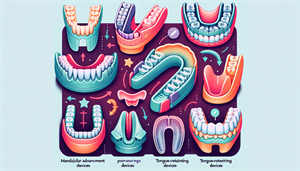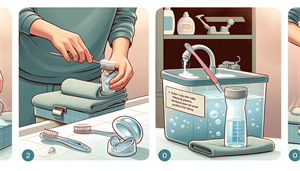Are snoring mouthpieces safe? These FDA-approved devices are generally safe but do come with possible risks and side effects.
This article will dive into what you need to know about the safety of snoring mouthpieces, the common side effects, and considerations for long-term use.
Key Takeaways
-
Snoring mouthpieces, including MADs and TRDs, effectively reduce snoring by keeping the airway open, but they may cause temporary side effects such as tooth sensitivity and jaw discomfort.
-
The safety of snoring mouthpieces is generally supported by FDA approval, but users should have regular dental check-ups to monitor for long-term risks like tooth movement and bite changes.
-
Consulting a healthcare professional is essential for selecting the right mouthpiece and ensuring its effectiveness, as custom-made devices typically provide better comfort and fit than over-the-counter options.
Understanding Snoring Mouthpieces

Snoring mouthpieces, also called anti-snoring mouthguards or oral appliances, provide a practical solution for those who snore. These anti snoring devices work by applying light tension to the lower jaw and pulling the tongue forward to clear the airway, thereby reducing the vibrations that cause snoring sounds. They are designed to stabilize the soft tissues in the throat, preventing them from collapsing and creating the characteristic anti snoring mouthpiece noise.
There are different types of snoring mouthpieces, each tailored to address specific causes of snoring. Some devices, like mandibular advancement devices (MADs), work by slightly moving the jaw forward to keep the airway open. Others, such as tongue-retaining devices (TRDs), hold the tongue in place to prevent it from obstructing the airway. The primary function of these mouthpieces is to prevent airway blockages that lead to snoring and, in some cases, obstructive sleep apnea.
Comfort and fit are crucial when it comes to snoring mouthpieces. Custom mouth guards from dental solutions offer a personalized fit, ensuring they are comfortable and effective. These devices typically surround the upper teeth loosely, providing a snug fit without causing discomfort. Moreover, devices that use a pull effect to position the jaw and tongue are designed to be flexible and comfortable, making them suitable for long-term use.
Overall, snoring mouthpieces can be an effective means to treat snoring and improve sleep quality. These snoring aids reduce or eliminate snoring by preventing throat and soft tissue vibrations, resulting in more restful sleep for users and their partners.
Safety of Snoring Mouthpieces

Safety is a paramount concern when using a snoring mouthpiece. Oral appliances, such as mouth guards, work by positioning the lower jaw forward during sleep, effectively reducing snoring and improving airflow. These devices are generally safe and have been approved by the FDA for treating snoring and sleep apnea, providing reassurance about their safety standards.
However, like any medical device, snoring mouthpieces come with potential risks. Common side effects include tooth movements, jaw discomfort, tooth sensitivity, and shifting teeth. These side effects are typically mild and temporary but may require ongoing adjustments for comfort and effectiveness. Regular dental visits are essential to monitor these side effects and make necessary adjustments to the device.
Tooth movements and changes in bite alignment are potential long-term risks associated with the use of oral appliances. Prolonged use can lead to noticeable dental changes, such as altered bite or teeth shifting. Therefore, it is crucial to have regular follow-ups with a dental professional to address any issues that may arise and to ensure the device remains effective and comfortable.
Despite these potential risks, the benefits of using a snoring mouthpiece often outweigh the drawbacks. Regular use of these devices can significantly reduce snoring, improve sleep quality, and lower health risks associated with sleep apnea, making them a valuable tool in managing snoring and related sleep disorders.
Common Side Effects
While snoring mouthpieces can be effective in reducing snoring, they are not without their side effects. Common side effects include drooling, TMJ (temporomandibular joint) disturbances, tooth pain, and changes in bite alignment. These symptoms are typically mild and temporary, often resolving within a few weeks of continuous use.
Users may also experience mild jaw discomfort or tooth sensitivity when first using a snoring mouthpiece. This discomfort is usually due to the device applying light tension to the jaw and teeth to keep the airway open. Most users find that these symptoms improve over time as they get accustomed to the device. However, it is important to monitor these symptoms and consult a dental professional if they persist or worsen.
Despite these side effects, snoring mouthpieces remain a popular choice for treating snoring and mild sleep apnea. The benefits of improved sleep quality and reduced snoring often outweigh the temporary discomfort associated with these devices. Users are encouraged to give their bodies time to adjust and to seek professional advice if they experience significant discomfort or any unusual symptoms.
Long-Term Use Considerations
Long-term use of snoring mouthpieces can lead to several dental changes and complications. One of the most significant side effects is tooth movement, which occurs due to the continuous pressure exerted by the mouthpiece. These tooth movements are most prominent in the first two years of use but can continue beyond that. Users may notice changes in their bite alignment and the development of wider arches in the lower jaw.
Prolonged use of snoring mouthpieces can also result in increased gaps between teeth, altered bite, and soft tissue irritation. These changes can impact oral health and comfort, making regular dental check-ups essential. Dental professionals can monitor these changes and provide necessary adjustments to the device to mitigate these effects.
Dental follow-ups are essential for addressing potential issues from long-term snoring mouthpiece use. Check-ups allow for timely interventions to prevent significant dental changes and maintain the device’s effectiveness and comfort.
Types of Snoring Mouthpieces

Snoring mouthpieces come in two primary types: Mandibular Advancement Devices (MADs) and Tongue-Retaining Devices (TRDs). Each type functions differently to address the root causes of snoring, offering unique benefits and considerations for users.
Mandibular Advancement Devices (MADs) are recommended for their effectiveness in reducing snoring by moving the jaw forward to keep the airway open. Tongue-Retaining Devices (TRDs) hold the tongue forward to prevent airway obstruction.
Knowing the differences between these devices helps in choosing the right one for your needs.
Mandibular Advancement Devices
Mandibular Advancement Devices (MADs) work by moving the lower jaw forward to prevent airway blockage during sleep. This positioning keeps the airway open, reducing snoring vibrations. There are different designs available, including one-piece and two-piece devices, with customized versions providing better fit and comfort compared to over-the-counter options.
MADs are highly effective in reducing snoring and improving daytime sleepiness, making them a popular choice for many users. These devices can also help lower blood pressure by improving sleep quality and reducing the strain on the cardiovascular system. Adjustable MADs ensure a comfortable fit that keeps the airway open throughout the night.
Custom-made MADs, crafted from impressions of the user’s teeth, offer superior fit and effectiveness. These dental devices and oral device can be adjusted for maximum comfort and optimal airway positioning. Over-the-counter MADs, while more affordable, may not provide the same level of comfort and may require frequent replacements.
In summary, MADs are a proven solution for reducing snoring and improving overall sleep quality. Their ability to move the jaw forward and keep the airway open makes them an effective choice for many individuals struggling with snoring and mild sleep apnea.
Tongue-Retaining Devices
Tongue-Retaining Devices (TRDs) operate by holding the tongue in a forward position using suction, which helps keep the airway open during sleep. TRDs significantly reduce snoring and improve sleep quality by preventing the tongue from blocking the airway. This mechanism is especially beneficial for those whose snoring is caused by tongue obstruction.
One of the key benefits of TRDs is their ability to reduce pauses in breathing and improve blood oxygen levels during sleep. This can lead to a more restful sleep and reduce the risks associated with sleep apnea. However, TRDs are less commonly prescribed than Mandibular Advancement Devices (MADs) due to uncertainties regarding their long-term effectiveness and comfort.
TRDs are typically made from soft, flexible materials that provide comfort throughout the night. However, proper fitting is crucial to ensure the device remains effective. Custom-fitted TRDs, tailored to the user’s anatomy, tend to offer better results than over-the-counter options.
Although TRDs are a viable option for some, their usage should be closely monitored by a healthcare professional to ensure they are providing the desired benefits without causing significant discomfort.
Choosing the Right Snoring Mouthpiece

Choosing the right snoring mouthpiece is vital for achieving desired results and ensuring comfort. Comfort is a key factor, as a poorly fitting device can disrupt sleep rather than alleviate snoring. Mouth guards should be made from durable and flexible materials for comfort and longevity.
Custom-made mouth guards usually offer better fit and effectiveness than over-the-counter options. Tailored to the individual’s teeth impressions, these custom devices provide a snug and comfortable fit. The boil-and-bite process for customizing mandibular advancement devices can greatly enhance comfort and effectiveness.
Adjustability is an important feature to consider when choosing a snoring mouthpiece. Devices that allow users to modify the positioning can enhance both comfort and effectiveness, ensuring that the airway remains open without causing undue discomfort. Qualified dentists can offer personalized fitting of oral appliances, enhancing comfort and effectiveness.
Consulting a dentist is crucial for diagnosing snoring and sleep apnea. Dentists can identify early symptoms and recommend the most suitable type of mouthpiece based on individual needs. This professional guidance ensures that users select the right device and use it correctly to achieve the best possible results.
Importance of Professional Consultation
Consulting a professional is essential when considering snoring mouthpieces. A doctor plays a critical role in assessing the appropriateness of oral appliance therapy and diagnosing conditions like obstructive sleep apnea. This initial assessment is crucial for determining the most effective treatment plan.
After a diagnosis, seeing a qualified dentist to examine mouth health and jaw mobility is important. Dentists can provide custom-made mouthpieces with a better fit and more comfort than over-the-counter options. These custom devices are tailored to the individual’s specific needs, ensuring optimal effectiveness and comfort.
Follow-up visits with healthcare professionals are crucial for adjusting the mouthpiece to ensure it remains effective and comfortable. Regular check-ups allow for timely interventions to address any issues that may arise, such as discomfort or changes in bite alignment. Consulting healthcare professionals before using a snoring mouthpiece ensures proper fit and effectiveness, leading to better outcomes.
Maintaining Your Snoring Mouthpiece

Maintaining your snoring mouthpiece properly is essential for its longevity and effectiveness. Clean your teeth before using the mouthpiece to prevent transferring dirt and bacteria to it. This maintains both oral hygiene and the cleanliness of the mouthpiece.
Rinse the mouthpiece with warm or room temperature water after removal. Clean periodically with a mixture of dish soap and warm water to remove debris. Avoid using a dishwasher or other machines for cleaning, as these can damage the mouthpiece.
Allow the mouthpiece to air dry completely before storage after cleaning. This prevents the growth of bacteria and ensures the device remains hygienic for future use. Following these maintenance steps prolongs the lifespan of the snoring mouthpiece and ensures effective snoring relief.
Alternatives to Snoring Mouthpieces
While effective, snoring and obstructive sleep mouthpieces have several alternative treatments available for those who may not find these devices suitable. Continuous Positive Airway Pressure (CPAP) therapy is commonly used to treat obstructive sleep apnea by keeping the airway open during sleep. This therapy involves wearing a mask that delivers a steady stream of air to prevent airway collapse.
Surgical options are available for those seeking a more permanent solution. Procedures like laser-assisted uvulopalatoplasty and palatal implants alleviate snoring by removing or stiffening throat tissue. Somnoplasty, using radio waves to modify throat tissue, is another effective surgical option for reducing snoring.
Lifestyle changes significantly reduce snoring. Weight loss, smoking cessation, and reducing alcohol consumption, especially before bedtime, can diminish snoring. Changing sleep positions, particularly sleeping on one’s side, can significantly reduce snoring for many.
Non-surgical options like nasal dilators and oropharyngeal exercises also lower snoring. Nasal dilators improve airflow during sleep, while oropharyngeal exercises strengthen mouth and throat muscles. These alternatives offer options for individuals seeking to reduce or eliminate snoring without using mouthpieces.
Summary
In summary, snoring mouthpieces offer an effective solution for many individuals struggling with snoring and mild sleep apnea. These devices work by keeping the airway open, reducing the vibrations that cause snoring. While they are generally safe and FDA-approved, it is important to be aware of potential side effects and long-term use considerations. Regular dental visits and professional consultations are crucial for ensuring the effectiveness and comfort of these devices.
For those who may not find snoring mouthpieces suitable, several alternative treatments are available, including CPAP therapy, surgical options, lifestyle changes, and non-surgical interventions. By exploring these options and consulting with healthcare professionals, individuals can find the most effective solution to improve their sleep quality and overall well-being.
Frequently Asked Questions
Are snoring mouthpieces safe to use?
Snoring mouthpieces are generally safe to use and are often FDA-approved. However, users should be aware of potential risks such as tooth movement and jaw discomfort, which can be monitored through regular dental check-ups.
What are the common side effects of using a snoring mouthpiece?
Common side effects of using a snoring mouthpiece typically include drooling, TMJ disturbances, tooth pain, and changes in bite alignment. These symptoms are generally mild and temporary, often improving with continued use.
How do I choose the right snoring mouthpiece?
Choosing the right snoring mouthpiece hinges on comfort and fit, with custom-made mouth guards generally providing superior effectiveness over over-the-counter alternatives. It is advisable to consult a dentist to ensure a personalized fitting that addresses your specific needs.
How should I maintain my snoring mouthpiece?
To ensure proper maintenance of your snoring mouthpiece, clean your teeth before use, rinse the mouthpiece with warm water after removal, and periodically wash it with dish soap and warm water. Allow it to air dry completely before storing it for optimal hygiene.
What are some alternatives to snoring mouthpieces?
CPAP therapy, surgical procedures such as laser-assisted uvulopalatoplasty, lifestyle modifications like weight loss and quitting smoking, and non-surgical options including nasal dilators and oropharyngeal exercises serve as effective alternatives to snoring mouthpieces. Each option can significantly contribute to reducing snoring.


